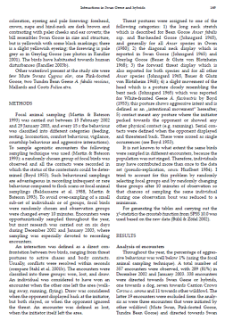- Search in all Repository
- Literature and maps
- Archeology
- Mills database
- Natural sciences
Advanced search
Advanced search
Advanced search
Advanced search
Advanced search

Object
Title: Prey Size Selection of Insular Lizards by Two Sympatric Predatory Bird Species
Subtitle:
Selekcja na wielkość zdobyczy sympatrycznie występujących srokosza i pustułki ; Selection of lizard size by predatory birds
Contributor:
Museum and Institute of Zoology, Polish Academy of Sciences
Publisher:
Museum and Institute of Zoology, Polish Academy of Sciences ; Natura Optima Dux Foundation
Place of publishing:
Description:
Type of object:
Abstract:
Size-related selection of insular lizards by two sympatric predatory bird species (Southern Grey Shrike and Eurasian Kestrel) was studied in an arid insular environment. The endemic lizard genus Gallotia was a key resource in the diet of both predators, constituting more than 50% of the total biomass. Shrikes captured smaller lizards than kestrels during all seasons (mean snout - vent length (SVL): 7.4 ±1.9 vs. 9.4 ± 2.1 cm respectively), presenting a sequential use of lizard sizes and avoiding potential competition. On the other hand, shrikes and kestrels showed the same seasonal variation pattern, capturing the largest lizards during their breeding periods (spring). Considering lizard availability, shrikes displayed less selective predation than kestrels in all seasons. Shrikes positively selected the medium lizard size (SVL: 5–10 cm) during the nestling period, but negatively selected the small lizard size (SVL: < 5 cm) in autumn and winter, probably due to an explosion of juvenile lizards. Lastly, kestrels appeared to be more selective, negatively choosing the small lizard size but positively selecting the largest ones all the year round (SVL: > 10 cm).
Relation:
Volume:
Issue:
Start page:
End page:
Detailed Resource Type:
Format:
Resource Identifier:
oai:rcin.org.pl:55655 ; 10.3161/068.042.0211
Source:
MiIZ PAN, sygn. P.4568 ; MiIZ PAN, sygn. P.257 ; click here to follow the link
Language:
Language of abstract:
Rights:
Prawa zastrzeżone - dostęp nieograniczony
Terms of use:
Digitizing institution:
Muzeum i Instytut Zoologii Polskiej Akademii Nauk
Original in:
Biblioteka Muzeum i Instytutu Zoologii PAN
Access:
Object collections:
- Digital Repository of Scientific Institutes > Partners' collections > Museum and Institute of Zoology PAS > Scientific Journals
- Digital Repository of Scientific Institutes > Partners' collections > Museum and Institute of Zoology PAS > MIZ PAN Publications > Acta Ornithologica
- Digital Repository of Scientific Institutes > Literature > Journals/Articles
Last modified:
Oct 2, 2020
In our library since:
Jul 30, 2015
Number of object content downloads / hits:
32
All available object's versions:
https://rcin.org.pl./publication/75727
Show description in RDF format:
Show description in RDFa format:
Show description in OAI-PMH format:
Objects Similar
Riegert, Jan Fainová, Drahomíra Mikeš, Václav Fuchs, Roman
Żmihorski, Michał Rejt, Łukasz
Salvati, Luca Manganaro, Alberto Fattorini, Simone Piattella, Emanuele
Rejt, Łukasz Turlejski, Krzysztof Bronche, Krzysztof Topczewski, Andrzej M.
Rodríguez, Airam Rodríguez, Beneharo Rumeu, Beatriz Nogales, Manuel
Löher, Franz von (1818–1892) Velhagen & Klasing. Wydawca
Pellew, R. A.

 INSTYTUT ARCHEOLOGII I ETNOLOGII POLSKIEJ AKADEMII NAUK
INSTYTUT ARCHEOLOGII I ETNOLOGII POLSKIEJ AKADEMII NAUK
 INSTYTUT BADAŃ LITERACKICH POLSKIEJ AKADEMII NAUK
INSTYTUT BADAŃ LITERACKICH POLSKIEJ AKADEMII NAUK
 INSTYTUT BADAWCZY LEŚNICTWA
INSTYTUT BADAWCZY LEŚNICTWA
 INSTYTUT BIOLOGII DOŚWIADCZALNEJ IM. MARCELEGO NENCKIEGO POLSKIEJ AKADEMII NAUK
INSTYTUT BIOLOGII DOŚWIADCZALNEJ IM. MARCELEGO NENCKIEGO POLSKIEJ AKADEMII NAUK
 INSTYTUT BIOLOGII SSAKÓW POLSKIEJ AKADEMII NAUK
INSTYTUT BIOLOGII SSAKÓW POLSKIEJ AKADEMII NAUK
 INSTYTUT CHEMII FIZYCZNEJ PAN
INSTYTUT CHEMII FIZYCZNEJ PAN
 INSTYTUT CHEMII ORGANICZNEJ PAN
INSTYTUT CHEMII ORGANICZNEJ PAN
 INSTYTUT FILOZOFII I SOCJOLOGII PAN
INSTYTUT FILOZOFII I SOCJOLOGII PAN
 INSTYTUT GEOGRAFII I PRZESTRZENNEGO ZAGOSPODAROWANIA PAN
INSTYTUT GEOGRAFII I PRZESTRZENNEGO ZAGOSPODAROWANIA PAN
 INSTYTUT HISTORII im. TADEUSZA MANTEUFFLA POLSKIEJ AKADEMII NAUK
INSTYTUT HISTORII im. TADEUSZA MANTEUFFLA POLSKIEJ AKADEMII NAUK
 INSTYTUT JĘZYKA POLSKIEGO POLSKIEJ AKADEMII NAUK
INSTYTUT JĘZYKA POLSKIEGO POLSKIEJ AKADEMII NAUK
 INSTYTUT MATEMATYCZNY PAN
INSTYTUT MATEMATYCZNY PAN
 INSTYTUT MEDYCYNY DOŚWIADCZALNEJ I KLINICZNEJ IM.MIROSŁAWA MOSSAKOWSKIEGO POLSKIEJ AKADEMII NAUK
INSTYTUT MEDYCYNY DOŚWIADCZALNEJ I KLINICZNEJ IM.MIROSŁAWA MOSSAKOWSKIEGO POLSKIEJ AKADEMII NAUK
 INSTYTUT PODSTAWOWYCH PROBLEMÓW TECHNIKI PAN
INSTYTUT PODSTAWOWYCH PROBLEMÓW TECHNIKI PAN
 INSTYTUT SLAWISTYKI PAN
INSTYTUT SLAWISTYKI PAN
 SIEĆ BADAWCZA ŁUKASIEWICZ - INSTYTUT TECHNOLOGII MATERIAŁÓW ELEKTRONICZNYCH
SIEĆ BADAWCZA ŁUKASIEWICZ - INSTYTUT TECHNOLOGII MATERIAŁÓW ELEKTRONICZNYCH
 MUZEUM I INSTYTUT ZOOLOGII POLSKIEJ AKADEMII NAUK
MUZEUM I INSTYTUT ZOOLOGII POLSKIEJ AKADEMII NAUK
 INSTYTUT BADAŃ SYSTEMOWYCH PAN
INSTYTUT BADAŃ SYSTEMOWYCH PAN
 INSTYTUT BOTANIKI IM. WŁADYSŁAWA SZAFERA POLSKIEJ AKADEMII NAUK
INSTYTUT BOTANIKI IM. WŁADYSŁAWA SZAFERA POLSKIEJ AKADEMII NAUK


































